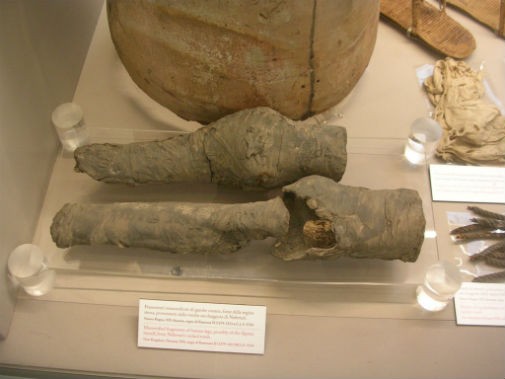By Ana Verayo, | December 06, 2016

Archaeologists believe they have identified the mummified legs of Queen Nefertari. (Joann Fletcher/University of York)
In an astonishing discovery, archaeologists have hunted down the mummified remains of one of Egypt's most famous queens, Nefertari Meritmut, who was one of the Great Royal Wives of Rameses the Great. The team only found a part of Queen Nefertari's body; her mummified knees housed in an Egyptian Museum in Italy.
Like Us on Facebook
A team from the University of York identified the ancient remains with the help of radiocarbon dating including chemical and genetic analysis as well as anthropology- and paleopathology-based techniques.
With the help of chemical analysis, the team determined that the embalming materials used were consistent with ancient mummification methods that were popular in 13th century B.C.E. Further tests estimated the queen's age at the time of her death was 40. After taking into consideration all these crucial evidence, the team suggests that these remains belong to Queen Nefertari.
"This is definitely one of the most exciting projects I had the honor of being a part of and also, this has been a great privilege to work with some of the world's leading experts and archaeologists," Egyptologist Joann Fletcher of the Department of Archaeology at the University of York, said.
Nefertari was buried in an exquisite tomb in the Valley of the Queens in Luxor, New Valley Governorate in Egypt. However, looters and treasure hunters have stolen most of the items buried with her in the tomb. Nefertari's tomb was first excavated by Italian archaeologists in 1904 and the artifacts found, including her mummified legs, were sent to the Egyptian Museum in Turin.
This study is the first time that scientists have analyzed the queen's mummified legs.
"We have been doing extensive research on this for a long time now, and our past evidence with Egypt's Royal mummies complements with the Queen and her tomb, also revealing more crucial clues about the process of Egyptian mummification," Fletcher explained.
This new study was published in the journal, PLOS ONE.
-
Use of Coronavirus Pandemic Drones Raises Privacy Concerns: Drones Spread Fear, Local Officials Say

-
Coronavirus Hampers The Delivery Of Lockheed Martin F-35 Stealth Fighters For 2020

-
Instagram Speeds Up Plans to Add Account Memorialization Feature Due to COVID-19 Deaths

-
NASA: Perseverance Plans to Bring 'Mars Rock' to Earth in 2031

-
600 Dead And 3,000 In The Hospital as Iranians Believed Drinking High-Concentrations of Alcohol Can Cure The Coronavirus

-
600 Dead And 3,000 In The Hospital as Iranians Believed Drinking High-Concentrations of Alcohol Can Cure The Coronavirus

-
COVID-19: Doctors, Nurses Use Virtual Reality to Learn New Skills in Treating Coronavirus Patients







